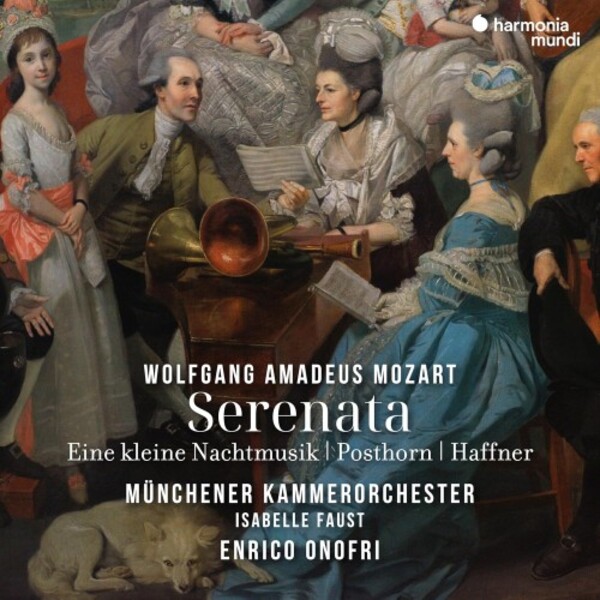MOZART Serenata (Onofri)
View record and artist detailsRecord and Artist Details
Genre:
Orchestral
Label: Harmonia Mundi
Magazine Review Date: 03/2025
Media Format: CD or Download
Media Runtime: 141
Mastering:
DDD
Catalogue Number: HMM90 5396-97

Tracks:
| Composition | Artist Credit |
|---|---|
| (2) Marches |
Wolfgang Amadeus Mozart, Composer
Enrico Onofri, Conductor Munich Chamber Orchestra |
| Serenade No. 9, "Posthorn" |
Wolfgang Amadeus Mozart, Composer
Enrico Onofri, Conductor Munich Chamber Orchestra |
| Serenade No. 13, "Eine kleine Nachtmusik" |
Wolfgang Amadeus Mozart, Composer
Enrico Onofri, Conductor Munich Chamber Orchestra |
| March |
Wolfgang Amadeus Mozart, Composer
Enrico Onofri, Conductor Munich Chamber Orchestra |
| Serenade No. 7, "Haffner" |
Wolfgang Amadeus Mozart, Composer
Enrico Onofri, Conductor Munich Chamber Orchestra |
Author: David Threasher
Mozart’s Eine kleine Nachtmusik is one of those few works in the classical canon that have crossed over into the general consciousness. It’s implanted itself in the collective memory via its use as everything from a highbrow quiz show theme tune (the finale) to insolent playground chants (the first movement). The opening few bars are currently being used, accompanied by coughs and sneezes, as a radio advert for tissues. More commonly it is deployed in films to imply a certain degree of classiness.
Its sheer familiarity perhaps leads us to take it for granted as superior light music. In one sense it is just that – but it’s also a supreme product of Mozart’s purplest period of creativity, a time that also saw the creation of Don Giovanni. Get beyond those instantly recognisable tunes and you realise how finely wrought it is, how consummate the craftsmanship. How, then, to make such a well-known work sound new and original?
For a start, Enrico Onofri has the Munich Chamber Orchestra – modern instruments but basses strung with gut; natural brass and historical timps in the larger works here – play in a period-aware style, with minimal vibrato and an avoidance of the rich-toned blend and sustain favoured by the virtuoso string orchestras of the past. It’s a slimmer, more sinewy sound, the physique of individual lines within the texture allowed to poke through. Then there are certain attention-seeking tweaks to the phrasing – an unexpected legato here, a sudden unmarked accent there, droopy diminuendos at cadences and a big portamento (bringing a big smile) just a few bars into the finale. Whether the results are endearing or eccentric is in the ear of the beholder; Eine kleine nevertheless certainly emerges in a refreshingly idiosyncratic way.
It’s sandwiched here between a pair of Mozart’s Salzburg orchestral serenades of the 1770s. If the individualities of Onofri’s Eine kleine aren’t as apparent in these earlier, more uncomplicated works, the recreative spirit certainly is. Isabelle Faust is luxury casting in the three concertante movements of the Haffner (no relation to the Haffner Symphony, although the Haffners for whom the two works were written were brother and sister), trumpeter Matthew Sadler taking the titular role in the Posthorn. Serenades in late 18th-century Austria were performed outdoors, and if they sounded anything like these boldly characterised, highly coloured readings, one can easily imagine their strains travelling far into the Salzburg night.
Discover the world's largest classical music catalogue with Presto Music.

Gramophone Digital Club
- Digital Edition
- Digital Archive
- Reviews Database
- Full website access
From £8.75 / month
Subscribe
Gramophone Full Club
- Print Edition
- Digital Edition
- Digital Archive
- Reviews Database
- Full website access
From £11.00 / month
Subscribe
If you are a library, university or other organisation that would be interested in an institutional subscription to Gramophone please click here for further information.




